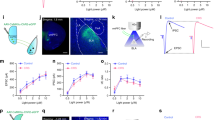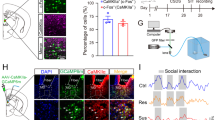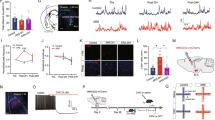Abstract
The medial prefrontal cortex (mPFC) sends projections to numerous brain regions and is believed to play a significant role in depression and anxiety. One of the key downstream targets of the mPFC, the lateral habenula (LHb), is essential for chronic stress (CS)-induced depressive and anxiety-like behaviors. Nevertheless, whether the mPFC-LHb pathway mediates the co-occurrence of depression and anxiety and the underlying mechanism remain incompletely understood. Here, using chemogenetics, we first determined that activation of LHb-projecting mPFC neurons is essential for the development of depressive and anxiety-like behaviors induced by CS. Subsequently, we identify the extent and distribution of LHb-projecting neurons originating from the mPFC subregion. Through circuit-specific in vivo fiber photometry, we found that Ca2+ activity in dorsal mPFC (dmPFC) axon terminals within the LHb was increased during exposure to stressful and anxiety-related stimuli, highlighting the potential role of LHb-projecting dmPFC neurons in conveying stressful and anxiety-related information to the LHb. Finally, we observed that activation of both LHb-projecting dmPFC neurons and their postsynaptic counterparts in the LHb was necessary for CS-induced depressive and anxiety-like behaviors. Overall, this study provides multiple lines of evidence demonstrating that activation of the dmPFC-LHb pathway is a crucial neural circuitry for CS-induced depressive and anxiety-like behaviors.
This is a preview of subscription content, access via your institution
Access options
Subscribe to this journal
Receive 13 print issues and online access
$259.00 per year
only $19.92 per issue
Buy this article
- Purchase on Springer Link
- Instant access to full article PDF
Prices may be subject to local taxes which are calculated during checkout





Similar content being viewed by others
Data availability
The raw data that support the findings of the current study are available from the corresponding author upon reasonable request.
References
Kessler RC, Berglund P, Demler O, Jin R, Koretz D, Merikangas KR, et al. The epidemiology of major depressive disorder: results from the National Comorbidity Survey Replication (NCS-R). JAMA. 2003;289:3095–105.
Lépine JP, Briley M. The increasing burden of depression. Neuropsychiatr Dis Treat. 2011;7:3–7.
Kaufman J, Charney D. Comorbidity of mood and anxiety disorders. Depress Anxiety. 2000;12:69–76.
Berton O, Nestler EJ. New approaches to antidepressant drug discovery: beyond monoamines. Nat Rev Neurosci. 2006;7:137–51.
Lin S, Huang L, Luo ZC, Li X, Jin SY, Du ZJ, et al. The ATP level in the medial prefrontal cortex regulates depressive-like behavior via the medial prefrontal cortex-lateral habenula pathway. Biol Psychiatry. 2022;92:179–92.
Hare BD, Duman RS. Prefrontal cortex circuits in depression and anxiety: contribution of discrete neuronal populations and target regions. Mol Psychiatry. 2020;25:2742–58.
Anastasiades PG, Carter AG. Circuit organization of the rodent medial prefrontal cortex. Trends Neurosci. 2021;44:550–63.
Bittar TP, Labonte B. Functional contribution of the medial prefrontal circuitry in major depressive disorder and stress-induced depressive-like behaviors. Front Behav Neurosci. 2021;15:699592.
Chen Y, Hu N, Yang J, Gao T. Prefrontal cortical circuits in anxiety and fear: an overview. Front Med. 2022;16:518–39.
Hu H, Cui Y, Yang Y. Circuits and functions of the lateral habenula in health and in disease. Nat Rev Neurosci. 2020;21:277–95.
Ables JL, Park K, Ibanez-Tallon I. Understanding the habenula: a major node in circuits regulating emotion and motivation. Pharmacol Res. 2023;190:106734.
Huang L, Chen X, Tao Q, Wang X, Huang X, Fu Y, et al. Bright light treatment counteracts stress-induced sleep alterations in mice, via a visual circuit related to the rostromedial tegmental nucleus. PLoS Biol. 2023;21:e3002282.
Huang L, Xi Y, Peng Y, Yang Y, Huang X, Fu Y, et al. A visual circuit related to habenula underlies the antidepressive effects of light therapy. Neuron. 2019;102:128–42.e8.
Vertes RP. Differential projections of the infralimbic and prelimbic cortex in the rat. Synapse. 2004;51:32–58.
Hoover WB, Vertes RP. Anatomical analysis of afferent projections to the medial prefrontal cortex in the rat. Brain Struct Funct. 2007;212:149–79.
Heidbreder CA, Groenewegen HJ. The medial prefrontal cortex in the rat: evidence for a dorso-ventral distinction based upon functional and anatomical characteristics. Neurosci Biobehav Rev. 2003;27:555–79.
Yashima J, Uekita T, Sakamoto T. The prelimbic cortex but not the anterior cingulate cortex plays an important role in social recognition and social investigation in mice. PLoS ONE. 2023;18:e0284666.
de Kloet SF, Bruinsma B, Terra H, Heistek TS, Passchier EMJ, van den Berg AR, et al. Bi-directional regulation of cognitive control by distinct prefrontal cortical output neurons to thalamus and striatum. Nat Commun. 2021;12:1994.
Wang M, Gallo NB, Tai Y, Li B, Van Aelst L. Oligophrenin-1 moderates behavioral responses to stress by regulating parvalbumin interneuron activity in the medial prefrontal cortex. Neuron. 2021;109:1636–56.e8.
Bi LL, Wang J, Luo ZY, Chen SP, Geng F, Chen YH, et al. Enhanced excitability in the infralimbic cortex produces anxiety-like behaviors. Neuropharmacology. 2013;72:148–56.
Perova Z, Delevich K, Li B. Depression of excitatory synapses onto parvalbumin interneurons in the medial prefrontal cortex in susceptibility to stress. J Neurosci. 2015;35:3201–6.
Covington HE 3rd, Lobo MK, Maze I, Vialou V, Hyman JM, Zaman S, et al. Antidepressant effect of optogenetic stimulation of the medial prefrontal cortex. J Neurosci. 2010;30:16082–90.
Lee EH, Park JY, Kwon HJ, Han PL. Repeated exposure with short-term behavioral stress resolves pre-existing stress-induced depressive-like behavior in mice. Nat Commun. 2021;12:6682.
Huang WC, Zucca A, Levy J, Page DT. Social behavior is modulated by valence-encoding mPFC-amygdala sub-circuitry. Cell Rep. 2020;32:107899.
Liu WZ, Zhang WH, Zheng ZH, Zou JX, Liu XX, Huang SH, et al. Identification of a prefrontal cortex-to-amygdala pathway for chronic stress-induced anxiety. Nat Commun. 2020;11:2221.
Cui Y, Huang X, Huang P, Huang L, Feng Z, Xiang X, et al. Reward ameliorates depressive-like behaviors via inhibition of the substantia innominata to the lateral habenula projection. Sci Adv. 2022;8:eabn0193.
Warden MR, Selimbeyoglu A, Mirzabekov JJ, Lo M, Thompson KR, Kim SY, et al. A prefrontal cortex-brainstem neuronal projection that controls response to behavioural challenge. Nature. 2012;492:428–32.
Benekareddy M, Stachniak TJ, Bruns A, Knoflach F, von Kienlin M, Künnecke B, et al. Identification of a corticohabenular circuit regulating socially directed behavior. Biol Psychiatry. 2018;83:607–17.
Mathis VP, Williams M, Fillinger C, Kenny PJ. Networks of habenula-projecting cortical neurons regulate cocaine seeking. Sci Adv. 2021;7:eabj2225.
Cao P, Chen C, Liu A, Shan Q, Zhu X, Jia C, et al. Early-life inflammation promotes depressive symptoms in adolescence via microglial engulfment of dendritic spines. Neuron. 2021;109:2573–89.e9.
Chana G, Landau S, Beasley C, Everall IP, Cotter D. Two-dimensional assessment of cytoarchitecture in the anterior cingulate cortex in major depressive disorder, bipolar disorder, and schizophrenia: evidence for decreased neuronal somal size and increased neuronal density. Biol Psychiatry. 2003;53:1086–98.
Yang Y, Cui Y, Sang K, Dong Y, Ni Z, Ma S, et al. Ketamine blocks bursting in the lateral habenula to rapidly relieve depression. Nature. 2018;554:317–22.
Acknowledgements
We thank Drs. Chaoran Ren and Jichun Zhang for their technical support.
Funding
This work was supported by the Science and Technology Program of Guangzhou (202201010195 for SL), the Guangdong Basic and Applied Basic Research Foundation (2023A1515010478 for SL; 2021B1515020035 for LH), National Natural Science Foundation of China (32171009 for LH), and Young Elite Scientist Sponsorship Program by CAST (YESS20210181 for LH).
Author information
Authors and Affiliations
Contributions
SL and LH designed the experiments and wrote the manuscript. XHT, RZS, and YXH performed the behavioral experiments and in vivo fiber photometry experiments. XHT performed the surgery with the help of XWL and YS. JJW performed the electrophysiological recordings. XHT, RZS, HL, YS, and CXC performed histology and microscopy. XHT, JJW, YXH, LH, and SL analyzed the data.
Corresponding authors
Ethics declarations
Competing interests
The authors declare no competing interests.
Additional information
Publisher’s note Springer Nature remains neutral with regard to jurisdictional claims in published maps and institutional affiliations.
Supplementary information
Rights and permissions
Springer Nature or its licensor (e.g. a society or other partner) holds exclusive rights to this article under a publishing agreement with the author(s) or other rightsholder(s); author self-archiving of the accepted manuscript version of this article is solely governed by the terms of such publishing agreement and applicable law.
About this article
Cite this article
Tong, X., Wu, J., Sun, R. et al. Elevated dorsal medial prefrontal cortex to lateral habenula pathway activity mediates chronic stress-induced depressive and anxiety-like behaviors. Neuropsychopharmacol. (2024). https://doi.org/10.1038/s41386-024-01840-3
Received:
Revised:
Accepted:
Published:
DOI: https://doi.org/10.1038/s41386-024-01840-3



